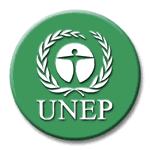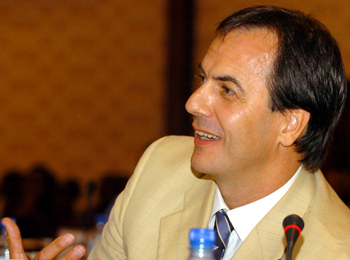|
|
|
|
|
|
|
Daily Web Coverage
|
|
 |
|
|
|
|
|
Summary report
|
|
|
|
| 12 September 2005 |
 |
 |
 |
|
|
|
|
Highlights from Thursday, 8 September 2005
The first meeting of
the Council of the Great Apes Survival
Project (GRASP Council), chaired by
Moses Mapesa Wafula, Executive Director,
Uganda Wildlife Authority, concluded its
work today, meeting in plenary
throughout the day. In the morning,
delegates agreed to the GRASP Outline
Work Plan for 2003-2007 (2003-2007 Work
Plan) and to the GRASP outline of
Current Priorities (GRASP Current
Priorities). In the afternoon, delegates
finalized a draft decision on these
documents, elected members and the chair
of the Executive Committee, were briefed
on the draft declaration from the
Intergovernmental Meeting (IGM), and
elected the chair of the GRASP Council.
In the morning,
delegates first heard a statement on
behalf of indigenous groups from the
Democratic Republic of Congo (DRC),
represented by the UNION FOR THE
EMANCIPATION OF INDIGENOUS WOMEN (UEFA),
referring to the plight of the Pigmy
people living in forestry ecosystems in
the DRC. She asked that range State
indigenous peoples be recognized as
members of GRASP and called for a
coherent programme of social measures.
 |
|
From left to right:
Natarajan Ishwaran,
Director of the UNESCO Division
of Ecological and Earth Sciences
and Secretary of the Man and
Biosphere Programme (MAB),
Samy Mankoto, Secretary
General of GRASP, First GRASP
Council Meeting Chair Mapesa
Wafula and Melanie Virtue,
GRASP Secretariat, field
questions on the workplan for
2003-2007 |
|
| |
|
Delegates
then
considered
and agreed
the amended
2003-2007
Work Plan.
Regarding
Output 3.2
(improving
modern
law-enforcing
techniques),
delegates
agreed to a
proposal by
CAMEROON to
include the
implementation
of training
in both
“internal
and
trans-boundary
law
enforcement
operations”
and
“awareness-raising
within
national
judiciary
and legal
systems”.
Delegates
also
stressed the
need to
involve
existing
military
forces in
law
enforcement
efforts,
with UNESCO
highlighting
the success
of such
activities
in rhino
conservation
in Nepal.
Regarding
Output 3.4
(strengthening
of
scientific
expertise on
great apes),
delegates
agreed to a
further
proposal by
CAMEROON
that the
GRASP
Partnership
“support
veterinarian
field
programmes
in great ape
disease
issues,
including
the setting
up of early
warning
systems for
Ebola and
anthrax,
based on ape
‘die-offs’”.
Regarding
Output 4.1
(pilot
projects in
great ape
conservation),
the
Convention
on Migratory
Species
(CMS) said
that both
Cross-river
and Mountain
gorillas
would almost
certainly be
listed under
the
convention
and that the
text be
amended
accordingly.
|
| |
 |
|
Denys Gauer, French
Ambassador for the Environment,
accepts the nomination of France
to the GRASP Council as a
representative of non-range
State governments |
|
|
 |
|
Bernard De Schrevel,
Attaché de la Coopération au
Développement, Secteur
agriculture et sécurité
alimentaire, Belgium,
takes the floor |
|
|
|
| |
|
|
 |
Stephen Takang Ebai,
Director of Wildlife and
Protected Areas representing
Cameroon following its selection
as the new GRASP Council
Chair |
|
|
 |
Yvette Kaboza (left) of
the World Heritage Centre at
UNESCO and Dominique Auger
of the UNEP Grasp
Secretariat, behind the scenes
translating one of the meeting
documents
|
|
|
|
|
| |
|
|
|
During the discussion, the REPUBLIC OF
CONGO, CAMEROON and others raised the
importance of monitoring and addressing
animal/human health issues and noted
that GRASP should be supportive of this
work. Delegates also debated a proposal
by CAMEROON for the compilation by GRASP
of a database of range State NGOs,
noting current work in this regard by
organizations such as IUCN, but agreed
to consider formal action on this at the
next GRASP Council meeting. Regarding
focal point support, Ian Redmond said an
informal document on the role of focal
points had been prepared by the
Technical Support Team, and will be
circulated to delegates for use as a
guide for national action.
Delegates then discussed the “Current
Priorities” document. IVORY COAST noted
the need to ensure that financial
resources are available for GRASP
activities. CAMEROON stressed the need
to ensure that changes made to the GRASP
Outline Work Plan document are reflected
in this document. Delegates then
approved the document.
WORLD
CONSERVATION SOCIETY then introduced a
draft decision that summarizes decisions
taken on both the 2003-2007 Work Plan
and the GRASP Current Priorities
document. UNEP proposed adding a
reference to the national strategies
range States are developing as providing
the overarching framework for the
activities that the GRASP Partnership is
undertaking. Stanley Johnson suggested
recording that the GRASP Council
unanimously adopted the 2003-2007 Work
Plan. Several delegates discussed the
need to insert wording that invites the
Executive Committee to consult with the
GRASP partners in the development of
2006-2007 Work. Following these and
other textual amendments, delegates
agreed to the draft decision.
Delegates then elected the members of
the Executive Committee, which will
consist of Indonesia, Uganda, Democratic
Republic of the Congo, Guinea, the
United Kingdom, France, UNEP, UNESCO,
CITES, the Wildlife Conservation Society
and the Orangutan Foundation-UK.
Delegates then unanimously elected
Cameroon as the new chair of the GRASP
Council. Speaking for the Government of
Cameroon, Stephen Takang Ebai noted his
government’s commitment to GRASP, and
stated that his government would forward
to the GRASP Secretariat the name of the
individual selected as the chair.
Delegates then thanked outgoing Chair
Moses Mapesa for his work, and expressed
their appreciation to those who
organized this meeting, especially the
GRASP Secretariat. The meeting closed at
4:50pm. |
|
|
|
|
|
|
|
|
|
|
|
|
|
|
|
|





